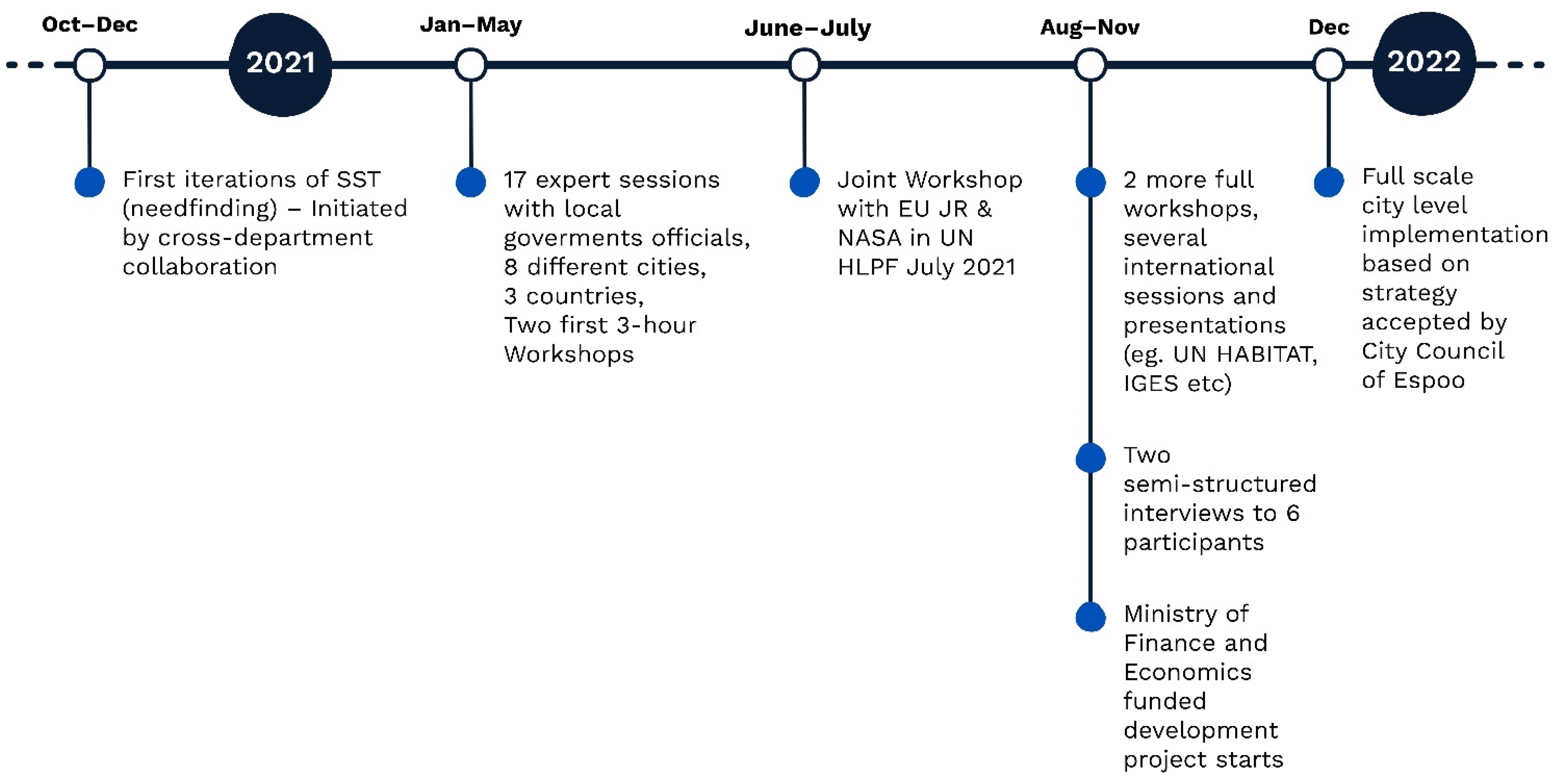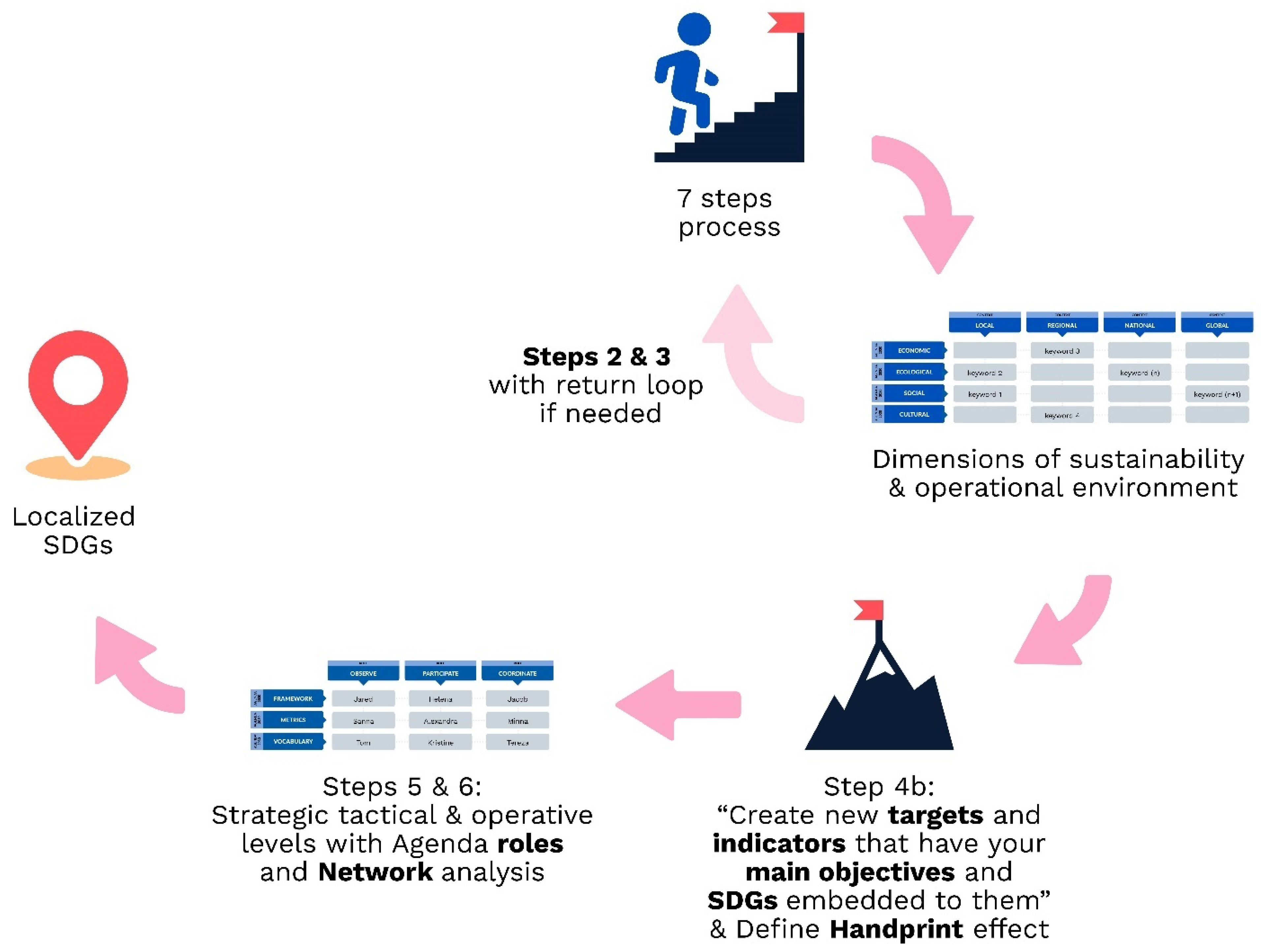Seven Steps to Strategic SDG Sensemaking for Cities
Abstract
:1. Introduction
2. Research Design and Questions
2.1. Process and Story behind the SDG Sensemaking Tool
2.2. Research Questions
- (1)
- What does it mean for a city to be committed to SDGs and their measurement?
- (2)
- How can a city use SDGs to make sense of, measure, monitor, and communicate both its present and future plans through SDGs aimed at nation states and the global level?
- (3)
- How does the tool manage to first make sense of and then reduce the process complexity, and thereby make the wicked problems of (sustainable) development simpler and more actionable?
3. Dilemmas of Planning Sustainable Development
3.1. Cities, Complexity and Wicked Problems
“…there are almost as many perspectives on the nature of a city as there are persons researching their structure, managing their organizations, or engaging with their design”.
3.2. UN Agenda 2030 and SDGs as a Framework, Metrics and a Vocabulary
3.3. Towards Sustainable Urban Governance
4. Seven Steps to Strategic SDG Sensemaking
4.1. SDG Sensemaking 101
4.2. SDG Sensemaking Process Step by Step
- Step 1 “Defining your work in relation to the SDGs”
- Step 2a “Different dimensions of sustainability”
- Step 2b “Dimensions mapped through SDGs”
- Step 2c “Main operational environment”
- Step 3a “Analysing dimensions and context together”
- Step 3b “Looping back to the start”
- Step 4a “Role of UN Agenda: Framework, Metrics, Vocabulary”
- Step 4b “Targets and Indicators”
- Step 4c “Handprint effect”
- Step 5 “Strategic, tactical and operative levels”
- Strategic: Direct link to city strategy
- Tactical: Project plan/action plan
- Operative: Part of daily practice
- Step 6 “Network and role of the UN Agenda”
- (1)
- Observe: Persons who know the content/project but do not participate in it;
- (2)
- Participate: Persons who are actively engaged in the work/project but not in charge of it; and
- (3)
- Responsible for coordination: Persons who are in charge of the work/project.
- Step 7 “Threats and opportunities, dialogue and concrete next steps”
- What issues make achieving the SDGs difficult?
- What issues help in achieving the SDGs?
- What concrete steps am I going to take to achieve the SDGs in my work?
4.3. Learnings from Workshops and Co-Developer Experiences
5. Conclusions
Author Contributions
Funding
Institutional Review Board Statement
Informed Consent Statement
Data Availability Statement
Acknowledgments
Conflicts of Interest
| 1 | espoo.fi/en (accessed on 10 February 2022). |
References
- Alberti, Valentina, Maria Alonso Raposo, Carmelo Attardo, Davide Auteri, Ricardo Ribeiro Barranco, Filipe Batista e Silva, Peter Benczur, Paolo Bertoldi, Flavio Bono, Ioris Bussolari, and et al. 2019. The Future of Cities—Opportunities, Challenges and the Way Forward. EUR 29752 EN, JRC116711. Edited by Ine Vandecasteele, Claudia Baranzelli, Alice Siragusa and Jean Philippe Aurambout. Luxembourg: Publications Office, ISBN 978-92-76-03847-4. [Google Scholar] [CrossRef]
- Batty, Michael. 2018. Reinventing Future Cities. Cambridge: MIT Press. [Google Scholar]
- Bettencourt, Luis. 2013. The origin of scaling in cities. Science 340: 1438–41. [Google Scholar] [CrossRef] [PubMed] [Green Version]
- Bettencourt, Luis. 2014. The Uses of Big Data in Cities. Big Data 2: 12–22. [Google Scholar] [CrossRef] [PubMed]
- Bettencourt, Luis. 2015. Cities as complex systems. In Modeling Complex Systems for Public Policies. Edited by Bernardo Alves Furtado, Patrícia A. M. Sakowski and Marina H. Tóvolli. Brasília: IPEA. [Google Scholar]
- Bettencourt, Luis. 2021. Introduction to Urban Science: Evidence and Theory of Cities as Complex Systems. Cambridge: MIT Press. [Google Scholar]
- Bisong, Peter, and Friday A. Oti. 2021. Hegelian Dialectics as an Approach to Organisational Conflict Management. Pinisi Journal of Art, Humanity and Social Studies 1: 1–6. [Google Scholar]
- Brydon-Miller, Mary, Davydd Greenwood, and Patricia Maguire. 2003. Why Action Research? Action Research 1: 9–28. [Google Scholar] [CrossRef]
- Costa, Joana, Diana Cancela, and João Reis. 2021. Neverland or Tomorrowland? Addressing (In)compatibility among the SDG Pillars in Europe. Int. J. Environ. Res. Public Health 18: 11858. [Google Scholar] [CrossRef] [PubMed]
- Espoo. 2020. Available online: www.espoo.fi/vlr (accessed on 10 February 2022).
- EU. 2021. Sustainable Development in the European Union Monitoring Report on Progress towards the SDGs in an EU Context, 2021 ed. Luxembourg: Publications Office of the European Union. [Google Scholar]
- Evans, Bob, Marko Joas, Susan Sundback, and Kate Theobald. 2006. Governing Local Sustainability. Journal of Environmental Planning and Management 49: 849–67. [Google Scholar] [CrossRef]
- Fatima, Zarrin, Uta Pollmer, Saga-Sofia Santala, Kaisa Kontu, and Marion Ticklen. 2021. Citizens and Positive Energy Districts: Are Espoo and Leipzig Ready for PEDs? Buildings 11: 102. [Google Scholar] [CrossRef]
- Fox, Sean, and Allan Macleod. 2021. Localizing the SDGs in cities: Reflections from an action research project in Bristol, UK. Urban Geography 42: 1–21. [Google Scholar] [CrossRef]
- Gandini, Alessandra, Laura Quesada, Iñaki Prieto, and Leire Garmendia. 2021. Climate change risk assessment: A holistic multi-stakeholder methodology for the sustainable development of cities. Sustainable Cities and Society 65: 102641. [Google Scholar] [CrossRef]
- Haarstad, Håvard. 2016. Constructing the sustainable city: Examining the role of sustainability in the ‘smart city’ discourse. Journal of Environmental Policy & Planning 19: 423–37. [Google Scholar] [CrossRef]
- Halko, Anni. 2021. Kestävän kehityksen johtaminen paikallistasolla—Tapaustutkimus Espoon edelläkävijyydestä [Leading Sustainable Development at a Local Level—Case study about Espoo SDG forerunner rol. Master’s thesis, Aalto University, Espoo, Finland. [Google Scholar]
- Harrison, Colin, Barbara Eckman, Rick Hamilton, Perry Hartswick, Jayant Kalagnanam, Jurij Paraszczak, and Peter Williams. 2010. Foundations for smarter cities. IBM Journal of Research and Development 54: 1–16. [Google Scholar] [CrossRef]
- Hassan, Abbas M., and Hyowon Lee. 2015. The paradox of the sustainable city: Definitions and examples. Environment, Development and Sustainability 17: 1267–85. [Google Scholar] [CrossRef]
- Hölscher, Katharina. 2019. Transforming Urban Climate Governance: Capacities for Transformative Climate Governance. Ph.D. dissertation, Erasmus University Rotterdam, Rotterdam, The Netherlands; p. 324. [Google Scholar]
- Immler, Nicole, and Hans Sakkers. 2021. The UN-Sustainable Development Goals going local: Learning from localising human rights. The International Journal of Human Rights 26: 262–84. [Google Scholar] [CrossRef]
- Intergovernmental Panel on Climate Change (IPCC). 2021. Climate Change 2021. The Physical Sciences Basis, IPCC 2021. Geneva: Intergovernmental Panel on Climate Change. [Google Scholar]
- Jabareen, Yosef. 2013. Planning the resilient city: Concepts and strategies for coping with climate change and environmental risk. Cities 31: 220–29. [Google Scholar] [CrossRef]
- Jacobs, Jane. 1961. The Death and Life of Great American Cities. New York: Vintage Books. [Google Scholar]
- Karanian, Barbara, Ville Taajamaa, Christopher Parlier, and Mona Eskandari. 2019. Provoked Emotion in Student Stories of Motivation Reveal Gendered Perceptions of What It Means to be Innovative in Engineering. Paper ID #26534, 1st Place Research Paper. Tampa: Entrepreneurship and Innovation Division for The American Society of Engineering Education (ASEE). [Google Scholar]
- Kettunen, Pekka, Hanna Heino, and Iina Sankala. 2019. Strategioista toiminnaksi? Kestävän kehityksen edistäminen paikallisella tasolla [From strategies to action? Promoting sustainable development at local level]. Focus Localis 47: 26–43. [Google Scholar]
- Lai, Shih-Kun. 2020. On the Solvability of Urban Complexity. Journal of Urban Management 9: 137. [Google Scholar] [CrossRef]
- Moyer, Jonathan, and David Bohl. 2019. Alternative pathways to human development: Assessing trade-offs and synergies in achieving the Sustainable Development Goals. Futures 105: 199–210. [Google Scholar] [CrossRef]
- Niiranen, Vuokko, and Minna Joensuu. 2014. Political Leaders and Public Administrators in Finland: Key Values and Stumbling Blocks in Decision Making and Interaction. In Strategic Management in Public Organizations. Edited by Paul Joyce and Anne Drumaux. Routledge: European Practices and Perspectives, pp. 95–114. [Google Scholar]
- OECD. 2021. Available online: www.oecd.org/dac/sustainable-development-goals.htm (accessed on 10 February 2022).
- Pradhan, Prajal, Luis Costa, Diego Rybski, Wolfgang Lucht, and Jürgen P. Kropp. 2017. A systematic study of sustainable development goal (SDG) interactions. Earth’s Future 5: 1169–79. [Google Scholar] [CrossRef] [Green Version]
- Puustinen, Alisa, and Harri Jalonen. 2020. Kompleksisuusajattelu—ymmärtämistä edistävä uusi lähestymistapa vai vanhaa viiniä uudessa pullossa? Johtaminen kompleksisessa maailmassa. Viisautta pirullisten ongelmien kohtaamiseen. [Complexity Thinking—A New Approach to Understanding, or Old Wine in a New Bottle? In Leadership in a Complex World. Wisdom to Face Wicked Problems]. Edited by Vartiainen Pirkko and Raisio Harri. Helsinki: Gaudeamus, pp. 15–36. [Google Scholar]
- Raisio, Harri, and Pirkko Vartiainen, eds. 2020. Oppeja kompleksisuuskuilun kaventamiseen. In Johtaminen kompleksisessa maailmassa. Viisautta pirullisten ongelmien kohtaamiseen. [Lessons for Bridging the Complexity Gap. In Leadership in a Complex World. Wisdom to Face Wicked Problems]. Helsinki: Gaudeamus. [Google Scholar]
- Rittel, Horst W. J., and Melvin Webber. 1973. Dilemmas in a general theory of planning. Policy Sciences 4: 155–69. [Google Scholar] [CrossRef]
- Snowden, David J., and Mary E. Boone. 2007. A Leaders Framework for Decision Making. Harvard Business Review 85: 68. [Google Scholar] [PubMed]
- Tsolov, Yulian, and Joern Geisselmann. 2021. Engaging Non-State Actors and Local Authorities in SDG Follow-Up and Review, Stocktaking, Evolving Practices and Lessons Learned. Bonn: Deutsche Gesellschaft für Internationale Zusammenarbeit (GIZ) GmbH. [Google Scholar]
- UN Habitat. 2016. Available online: www.habitat3.org/the-new-urban-agenda/ (accessed on 10 February 2022).
- United Nations Human Settlements Programme. 2020. New Urban Agenda, Illustrated. Nairobi: UN-Habitat. [Google Scholar]
- UNECE. 2020. People-Smart Sustainable Cities. Available online: https://unece.org/sites/default/files/2021-01/SSC%20nexus_web_opt_ENG.pdf (accessed on 10 February 2022).
- United Nations Population Division. 2020. World Urbanization Prospects: 2018 Revision. Available online: https://data.worldbank.org/indicator/SP.URB.TOTL.IN.ZS (accessed on 10 February 2022).
- Vartiainen, Pirkko, Seija Ollila, Harri Raisio, and Juha Lindell. 2013. Johtajana kaaoksen reunalla: Kuinka selviytyä pirullisista ongelmista. [As a Leader on the Brink of Chaos: How to Overcome Wicked Problems]. Helsinki: Gaudeamus. [Google Scholar]





Publisher’s Note: MDPI stays neutral with regard to jurisdictional claims in published maps and institutional affiliations. |
© 2022 by the authors. Licensee MDPI, Basel, Switzerland. This article is an open access article distributed under the terms and conditions of the Creative Commons Attribution (CC BY) license (https://creativecommons.org/licenses/by/4.0/).
Share and Cite
Taajamaa, V.; Joensuu, M.; Karanian, B.; Bettencourt, L. Seven Steps to Strategic SDG Sensemaking for Cities. Adm. Sci. 2022, 12, 33. https://doi.org/10.3390/admsci12010033
Taajamaa V, Joensuu M, Karanian B, Bettencourt L. Seven Steps to Strategic SDG Sensemaking for Cities. Administrative Sciences. 2022; 12(1):33. https://doi.org/10.3390/admsci12010033
Chicago/Turabian StyleTaajamaa, Ville, Minna Joensuu, Barbara Karanian, and Luis Bettencourt. 2022. "Seven Steps to Strategic SDG Sensemaking for Cities" Administrative Sciences 12, no. 1: 33. https://doi.org/10.3390/admsci12010033
APA StyleTaajamaa, V., Joensuu, M., Karanian, B., & Bettencourt, L. (2022). Seven Steps to Strategic SDG Sensemaking for Cities. Administrative Sciences, 12(1), 33. https://doi.org/10.3390/admsci12010033




